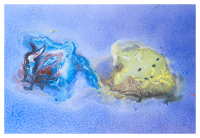Conveners
Parallel VI: F4 Nuclear and Astroparticle Physics
- Andreas Schmitt (Vienna University of Technology)
Vladyslav Shtabovenko
(TUM)
09/09/2014, 16:30
Section F: Nuclear and Astroparticle Physics
The properties of quarkonia in a nuclear medium are still poorly known, yet they are very important for the description of photo- and hadro-production of quarkonium on nuclear targets (e.g. in experiments at the FAIR facility at GSI) as well as for the diagnostic of hadronic final states in heavy ion collisions at the LHC at CERN.
Interactions of heavy quarkonia with hadrons or...
Prof.
Vladimir Kopeliovich
(Institute for Nuclear Research of RAS)
09/09/2014, 16:50
Section F: Nuclear and Astroparticle Physics
We show analytically that in the cumulative particles production off
nuclei multiple interactions lead to a glory-like backward focusing effect. Employing
the small phase space method we arrived at a characteristic angular dependence of the production cross section $d\sigma \sim 1/ \sqrt {\pi - \theta}$ near the strictly backward direction. This effect takes place for any number $n\geq 3 $...
Keisuke Ohtani
(Tokyo Institute of Technology)
09/09/2014, 17:10
Section F: Nuclear and Astroparticle Physics
The QCD sum rule method is a powerful tool for studying hadron properties directly from QCD.
In this method, the correlation function of an interpolating field operator coupled to the hadron of interest,
which can be calculated in the deep Euclidean region by the operator product expansion (OPE),
is related to the hadronic spectral function. The non-perturbative contributions in the...
Kenji Sasaki
(Univ. of Tsukuva)
09/09/2014, 17:30
Section F: Nuclear and Astroparticle Physics
Knowledge of baryon-baryon interactions with strangeness is important to study the hypernuclear structures and exotic few body states.
Especially for the strangeness S=-2 two-baryon system, it is interesting to investigate the SU(3) structure and its breaking effect of baryon-baryon interactions because the flavor singlet combination is allowed only in this system.
We report our latest...
Ramona Lea
(University and INFN Trieste)
09/09/2014, 17:50
Section F: Nuclear and Astroparticle Physics
Thanks to its excellent tracking performance and Particle Identification
capabilities, the ALICE detector allows for the identification of light
(anti-) (hyper-) nuclei and for the measurement of (multi-) strange particles
over a wide range of transverse momentum.
Deuterons, tritons, $\rm ^{3}{He}$ and $\rm ^{4}{He}$ and their corresponding
antinuclei are identified via their...
Kirill Lapidus
(TU Munich)
09/09/2014, 18:10
Section F: Nuclear and Astroparticle Physics
High-precision data on neutral kaon production collected by the HADES collaboration in proton-niobium collisions at a beam energy of 3.5 GeV were analysed with the aim to extract the kaon in-medium potential. Predictions of the Chiral Perturbation Theory (ChPT) for the kaon in-medium properties were tested by means of GiBUU transport model simulations. The uncertainties of the model were...
